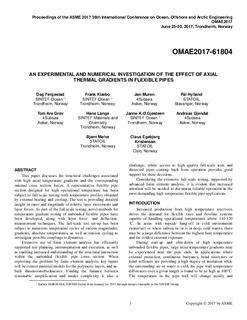| dc.contributor.author | Fergestad, Dag | |
| dc.contributor.author | Klæbo, Frank | |
| dc.contributor.author | Muren, Jan | |
| dc.contributor.author | Hylland, Pål | |
| dc.contributor.author | Grøv, Tom Are | |
| dc.contributor.author | Lange, Hans Iver | |
| dc.contributor.author | Gjøsteen, Janne Kristin Økland | |
| dc.contributor.author | Gjendal, Andreas | |
| dc.contributor.author | Melve, Bjørn | |
| dc.contributor.author | Kristensen, Claus Egeberg | |
| dc.date.accessioned | 2017-09-27T14:20:44Z | |
| dc.date.available | 2017-09-27T14:20:44Z | |
| dc.date.created | 2017-09-26T20:06:47Z | |
| dc.date.issued | 2017-09-21 | |
| dc.identifier.citation | ASME 2017 36th International Conference on Ocean, Offshore and Arctic Engineering Volume 5A: Pipelines, Risers, and Subsea Systems | |
| dc.identifier.isbn | 978-0-7918-5769-4 | |
| dc.identifier.uri | http://hdl.handle.net/11250/2457162 | |
| dc.description.abstract | This paper discusses the structural challenges associated with high axial temperature gradients and the corresponding internal cross section forces. A representative flexible pipe section designed for high operational temperature has been subject to full scale testing with temperature profiles obtained by external heating and cooling. The test is providing detailed insight in onset and magnitude of relative layer movements and layer forces. As part of the full-scale testing, novel methods for temperature gradient testing of unbonded flexible pipes have been developed, along with layer force- and deflection-measurement techniques. The full-scale test set-up has been subject to numerous temperature cycles of various magnitudes, gradients, absolute temperatures, as well as tension cycling to investigate possible couplings to dynamics.
Extensive use of finite element analysis has efficiently supported test planning, instrumentation and execution, as well as enabling increased understanding of the structural interaction within the unbonded flexible pipe cross section. When exploiting the problem by finite element analysis, key inputs will be correct material models for the polymeric layers, and as-built dimensions/thicknesses. Finding the balance between reasonable simplification and model complexity is also a challenge, where access to high quality full-scale tests and dissected pipes coming back from operation provides good support for these decisions.
Considering the extensive full scale testing, supported by advanced finite element analysis, it is evident that increased attention will be needed to document reliable operation in the most demanding high temperature flexible pipe applications. | |
| dc.language.iso | eng | nb_NO |
| dc.publisher | ASME | nb_NO |
| dc.relation.ispartof | ASME 2017 36th International Conference on Ocean, Offshore and Arctic Engineering - Volume 5A: Pipelines, Risers, and Subsea Systems | |
| dc.relation.ispartofseries | ASME Digital Collection;OMAE2017-61804 | |
| dc.rights | Attribution-NonCommercial-NoDerivatives 4.0 Internasjonal | * |
| dc.rights.uri | http://creativecommons.org/licenses/by-nc-nd/4.0/deed.no | * |
| dc.title | An Experimental and Numerical Investigation of the Effect of Axial Thermal Gradients in Flexible Pipes | nb_NO |
| dc.type | Chapter | nb_NO |
| dc.description.version | acceptedVersion | nb_NO |
| dc.rights.holder | Copyright © 2017 by ASME | nb_NO |
| dc.identifier.doi | 10.1115/OMAE2017-61804 | |
| dc.identifier.cristin | 1498615 | |
| cristin.unitcode | 7566,8,0,0 | |
| cristin.unitcode | 7401,80,6,5 | |
| cristin.unitname | Ocean Engineering | |
| cristin.unitname | Materialers integritet og sveising | |
| cristin.ispublished | true | |
| cristin.fulltext | postprint | |
| cristin.qualitycode | 1 | |

